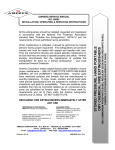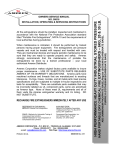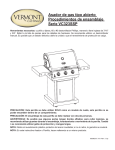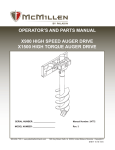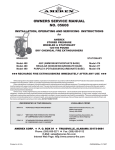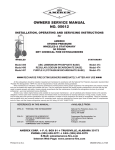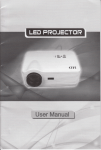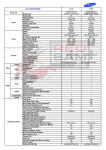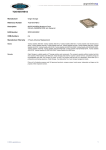Download OWNERS SERVICE MANUAL
Transcript
When maintenance is indicated, it should be performed by trained persons having proper equipment. Fire extinguishers are pressure vessels and must be treated with respect and handled with care. They are mechanical devices and require periodic maintenance to be sure that they are ready to operate properly and safely. Amerex strongly recommends that the maintenance of portable fire extinguishers be done by a trained professional – your local authorized Amerex Distributor. Amerex Corporation makes original factory parts available to insure proper maintenance – USE OF SUBSTITUTE PARTS RELEASES AMEREX OF ITS WARRANTY OBLIGATIONS. Amerex parts have machined surfaces and threads that are manufactured to exacting tolerances. O-rings, hoses, nozzles, and all metal parts meet precise specifications and are subjected to multiple in-house inspections and tests for acceptability. There are substitute parts available that may be incorrectly labeled as UL component parts, some are advertised as Amerex type. None of these meet UL requirements and all of them voids the Amerex extinguisher warranty and UL listing. DO NOT SUBSTITUTE. RECHARGE FIRE EXTINGUISHERS IMMEDIATELY AFTER ANY USE REFERENCES IN THIS MANUAL: NFPA-10 Portable Fire Extinguishers AVAILABLE FROM: National Fire Protection Association 1 Batterymarch Park, P.O, Box 9101 Quincy, MA 02269-9101 CGA C-1 Methods for Hydrostatic Testing of Compressed Gas Cylinders CGA C-6 Standard for Visual Inspection of Compressed Gas Cylinders Compressed Gas Association, Inc. 4221 Walney Road, 5th Floor Chantilly, VA 20151-2923 AMEREX CORPORATION – P.O. BOX 81 – TRUSSVILLE, ALABAMA 35173-0081 Phone: 205/655-3271 Fax: 800/654-5980 e-mail: [email protected] Web Page: http://www.amerex-fire.com Printed in U.S.A. 0M05602B Rev. 04/09 STORED PRESSURE, HAND PORTABLE DRY CHEMICAL FIRE EXTINGUISHERS All fire extinguishers should be installed, inspected and maintained in accordance with the National Fire Protection Association standard titled "Portable Fire Extinguishers", NFPA-10 and the requirements of local authorities having jurisdiction. ABC (AMMONIUM PHOSPHATE BASE), REGULAR (SODIUM BICARBONATE BASE), PURPKE K (POTASSIUM BICARBONATE BASE) OWNERS SERVICE MANUAL NO. 05602 INSTALLATION, OPERATING & SERVICING INSTRUCTIONS INSTALLATION Your layout and particular hazards dictate the placement of fire extinguishers. NFPA-10 requires that hand portable extinguishers with a gross weight less than 40 lbs. be hung with the top of the extinguisher not more than 5 ft. (1.53 m) above the floor. Extinguishers having a gross weight greater than 40 lbs. (18.14 kg) should be installed so that the top of the extinguisher is not more than 3 ½ ft. (1.07m) above the floor. All extinguishers should be in an accessible location and near an exit. Never install the extinguisher in a location where a potential hazard would prevent easy access. The operational temperature range for this extinguisher is -65°F to +120°F (-54°C to +49°C) or -40°F to +120°F (-40°C to +49°C) [please see the nameplate on your extinguisher]. The extinguisher should be adequately protected if temperatures outside of this range are anticipated. Keep the extinguisher clean and free from dirt, ice, chemicals and any contaminants that may interfere with its proper operation. DO NOT FUNCTIONALLY TEST THIS FIRE EXTINGUISHER. (Testing or any use may cause the extinguisher to gradually lose pressure over a period of time and make the extinguisher ineffective.) Never throw an extinguisher into a fire because rapid heat buildup could cause pressure expansion and exceed the limitations of the cylinder. OPERATION NOTE: Persons expected to use this extinguisher should be trained in initiating its operation and in the proper fire fighting technique. Familiarize all personnel with this information before an emergency occurs. 1. Remove the extinguisher from wall hanger or bracket. 2. Hold the extinguisher upright, twist and pull the ring (safety) pin, snapping the plastic lockwire seal. 3. Starting back a minimum of 8 feet from the fire, grasp the nozzle and aim at the base of the fire nearest you. 4. Keeping the extinguisher upright, squeeze the lever to discharge and sweep the chemical agent stream from side to side. Work the fire away from you while being alert for flashbacks. Move closer as the fire is extinguished but not so close as to scatter or splash the burning material. 5. When the fire is out, stand by and watch for possible re-ignition. 6. Evacuate and ventilate the area immediately after extinguishing the fire. The fumes and smoke from any fire may be hazardous and can be deadly. CAUTION: DISCHARGE TIME AND EFFECTIVE RANGE OF THE AGENT THROW VARIES ACCORDING TO MODEL – SEE THE SPECIFICATION LITERATURE FOR YOUR EXTINGUISHER. RECHARGE FIRE EXTINGUISHERS IMMEDIATELY AFTER ANY USE 1 AMEREX CORPORATION DOES NOT SERVICE, MAINTAIN OR RECHARGE FIRE EXTINGUISHERS. THIS MANUAL IS PUBLISHED AS A GUIDE TO ASSIST QUALIFIED SERVICE PERSONNEL IN THE INSPECTION, MAINTENANCE AND RECHARGE OF AMEREX FIRE EXTINGUISHERS ONLY. NO INSTRUCTION MANUAL CAN ANTICIPATE ALL POSSIBLE MALFUNCTIONS THAT MAY BE ENCOUNTERED IN THE SERVICE OF FIRE EXTINGUISHERS. DUE TO THE POSSIBILITY THAT PRIOR SERVICE PERFORMED ON THIS EQUIPMENT MAY HAVE BEEN IMPROPERLY DONE, IT IS EXTREMELY IMPORTANT THAT ALL WARNINGS, CAUTIONS AND NOTES IN THIS MANUAL BE CAREFULLY OBSERVED. FAILURE TO HEED THESE INSTRUCTIONS COULD RESULT IN SERIOUS INJURY. AMEREX ASSUMES NO LIABILITY FOR SERVICE, MAINTENANCE OR RECHARGE OF FIRE EXTINGUISHERS BY PUBLISHING THIS MANUAL. INSPECTING THE EXTINGUISHER This extinguisher should be inspected at regular intervals (monthly or more often if circumstances dictate) to insure that it is ready for use. Inspection is a "quick check" that a fire extinguisher is available and is in operating condition. It is intended to give reasonable assurance that the fire extinguisher is fully charged. This is done by verifying that it is in its designated place, that it has not been actuated or tampered with, and that there is no obvious physical damage or condition to prevent its operation. PERIODIC INSPECTION PROCEDURES (Monthly or more often if circumstances dictate) [NFPA-10] Periodic inspection of fire extinguishers shall include a check of at least the following items: 1. 2. 3. 4. 5. 6. Location in designated place. No obstruction to access or visibility. Pressure gauge reading or indicator in the operable range or position. Operating instructions on nameplate and facing outward. Safety seals and tamper indicators not broken or missing. Examination for obvious physical damage, corrosion, leakage, or clogged nozzle. MAINTENANCE [NFPA-10] At least once a year or more frequently if circumstances require, maintenance should be performed. Maintenance is a "thorough check" of the extinguisher. It is intended to give maximum assurance that a fire extinguisher will operate effectively and safely. It includes a thorough examination for physical damage or condition to prevent its operation and any necessary repair or replacement. It will normally reveal if hydrostatic testing or internal maintenance is required. 2 MAINTENANCE – SERVICE PROCEDURE WARNING: 1. BEFORE SERVICING BE SURE THE EXTINGUISHER AGENT CYLINDER IS NOT PRESSURIZED. THIS PROCEDURE IS BEST ACCOMPLISHED WITH THE EXTINGUISHER IN AN UPRIGHT POSITION AND ON A LEVEL SURFACE. Clean extinguisher to remove dirt, grease or foreign material. Check to make sure that the instruction nameplate is securely attached and legible. Inspect the cylinders for corrosion, abrasion, dents or weld damage. If any damage is found, hydrostatically test in accordance with instructions in CGA C-1 and C-6 and NFPA 10. Note: When cleaning, avoid use of solvents around the pressure gauge. They could seriously damage the plastic gauge face. 2. Inspect the extinguisher for damaged, missing or substitute parts. parts are approved for use on Amerex fire extinguishers. Only factory replacement 3. Weigh the extinguisher and compare with weight printed in the "Maintenance" section on the nameplate (label). Recharge extinguisher if weight is not within indicated allowable tolerances. 4. Check the date of manufacture printed on the extinguisher label (nameplate) or on the agent cylinder dome. The agent cylinder must be hydrostatically tested every 12 years to the test pressure indicated on the nameplate. 5. Visually inspect the pressure gauge: a. If bent, damaged or improper gauge, depressurize and replace. b. If pressure is low, check for leaks. c. If over pressurized (overcharged), depressurize the extinguisher and follow recharge instructions. 6. Check ring pin for freedom of movement. Replace if bent or if removal appears difficult. 7. Inspect discharge lever for any dirt or corrosion which might impair freedom of movement. Inspect carrying handle for proper installation. If lever, handle or rivets are damaged replace with proper Amerex part(s). 8. Install new tamper seal if broken and record service data on the extinguisher inspection tag. 9. Remove nozzle or hose and horn assembly and visually inspect inside valve body. (Chemical in the valve body may indicate that the extinguisher has been partially discharged and should therefore be recharged). Inspect nozzle or the hose & horn assembly for damage – replace as necessary. Blow air through nozzle or hose and horn to insure passage is clear of foreign material. 10. Inspect the valve assembly for corrosion or damage to hose thread connection. Replace valve assembly or component parts as necessary following the proper depressurization and recharge procedures. If valve removal is necessary, complete all steps in the Recharge Procedure. 11. Install nozzle or hose and horn assembly. 12. Replace the extinguisher on the wall hanger or in the vehicle bracket making sure that it fits the bracket properly and the bracket is securely attached – replace the bracket if necessary. 3 COMPLETE MAINTENANCE – SIX YEAR TEARDOWN [NFPA-10] Every six years, stored pressure extinguishers that require a 12 year hydrostatic test shall be emptied and subjected to the applicable maintenance procedures. When the applicable maintenance procedures are performed during periodic recharging or hydrostatic testing, the six year requirement shall begin from that date. NOTE: Some states have legislation which requires "Complete Maintenance" on an annual basis. Please contact your local Amerex Distributor to see if these requirements apply to you. 1. Discharge chemical and pressure into a "closed" dry chemical recovery system (several are commercially available). Make sure that the extinguisher is completely empty and depressurized. NOTE: A "closed recovery system" is designed to prevent loss of the chemical "fines". Loss of the "fines" could result in reduced extinguisher efficiency. 2. Clean extinguisher to remove dirt, grease or foreign material. Check to make sure that the instruction nameplate is securely fastened and legible. Inspect the cylinder for corrosion, abrasion, dents or weld damage. If any of these conditions are found and you doubt the integrity of the cylinder, hydrostatically test to factory test pressure marked on the nameplate (label), using the proof pressure method, in accordance with CGA C-1 and NFPA 10. NOTE: When cleaning, avoid use of solvents around the pressure gauge. They could seriously damage the plastic gauge face. 3. Inspect the extinguisher for damaged, missing or substitute parts. ONLY FACTORY REPLAEMENT PARTS ARE APPROVED FOR USE ON AMEREX FIRE EXTINGUISHERS. 4. Check the date of manufacture on the extinguisher label (nameplate). Cylinder must be hydrostatically (proof pressure) tested every 12 years to the test pressure indicated on the nameplate. 5. Visually inspect the pressure gauge – if bent, damaged or improper type or pressure – replace with the proper Amerex pressure gauge (see Parts List). 6. Check ring pin for freedom of movement. Replace if bent or if removal appears difficult. 7. Inspect discharge lever for any dirt or corrosion which might impair freedom of movement. Inspect carrying handle for proper installation. If lever, handle or rivets are damaged, replace with proper Amerex parts. 8. Remove nozzle or hose and horn assembly and visually inspect threads on nozzle or house coupling, horn and hose for damage, and replace as necessary. Blow air through nozzle or hose and horn to insure passage is clear of foreign material. 9. Inspect the valve assembly for corrosion or damage to nozzle or hose thread connection. Replace valve assembly or component parts as necessary. WARNING: Before attempting to disassemble the extinguisher be sure it is completely depressurized. 10. Remove and disassemble valve assembly by removing downtube, spring and valve stem assembly. Remove collar o-ring from valve. 11. Complete steps 3 through 14 of Recharge Procedure. 4 RECHARGE WARNING: a. Before attempting to disassemble, be sure the extinguisher is completely depressurized. b. Never have any part of your body over the extinguisher while removing the valve assembly. c. Use a protective shield between you and the pressure gauge while charging an extinguisher. Do not stand in front of the gauge if a shield is not available. d. Use a regulated pressurizing source of dry nitrogen only with a minimum dew point of minus 70ºF (minus 57C). Set the regulator to no more than 25 psi above the operating pressure. e. Check and calibrate regulator gauge at frequent intervals. The regulator gauge should be used to determine when the intended charging pressure has been reached. Do not use the extinguisher gauge for this purpose. f. Never leave an extinguisher connected to a regulator of a high pressure source for an extended period of time. A defective regulator could cause the cylinder to rupture due to excessive pressure. g. Do not mix types of dry chemicals in extinguishers, recharge or recovery systems. Mixing ABC (acidic base) with Regular, Purple-K, Super-K or Monnex (alkaline base) dry chemicals may result in a chemical reaction capable of developing a dangerous pressure buildup. RECHARGING PROCEDURE 1. Perform steps 1 through 10 of the "Complete Maintenance (Six Year Teardown)" section. 2. Thoroughly clean all parts of the disassembled valve with a soft bristle brush or soft cloth. Blow the valve out with air or nitrogen. Inspect the collar o-ring, valve stem, spring and downtube assembly, and replace parts if worn or damaged. Lubricate the collar o-ring and small o-ring on the valve stem with Visilox V-711 (do not lubricate the valve stem seal). 3. Reassemble the valve assembly, including downtube and set aside. 4. Remove any chemical remaining in the cylinder and check the condition. Properly dispose of any chemical that is contaminated or caked in accordance with local regulations. 5. Inspect the cylinder interior following CGA Visual Inspection Standard C-6. 6. Using an accurate scale, fill cylinder with the correct amount and type of dry chemical specified on the label (nameplate). Use Amerex chemical which has been kept free of moisture and contamination. CAUTION: Filling by eye alone could cause potentially dangerous overfilling – always use a scale. 7. Clean cylinder collar o-ring seat and collar threads with a small brush and then wipe off surfaces with a clean cloth to remove dust. Lightly brush the collar o-ring seat with Visilox V-711. 8. Carefully center the downtube and install valve assembly hand tight to the cylinder (the bottom of the valve body should touch the top of the cylinder collar). Attach the nitrogen charging adapter to the valve assembly. 9. With the extinguisher properly secured in an upright position, pressurizing line with a quick connect to the nitrogen charging extinguisher operating lever and pressurize extinguisher with dry operating pressure. When the desired pressure has been reached, off nitrogen supply and remove the quick connect. connect your nitrogen adapter. Depress the nitrogen to the proper release the lever. Shut 5 10. 11. Check extinguisher for leaks by applying detecting fluid or a solution of soapy water to the nitrogen charging adapter orifice, around the collar o-ring sealing area, cylinder welds and gauge. Remove the nitrogen charging adapter. Blow air or nitrogen into the interior of the valve assembly to remove any remaining leak detecting fluid. Wipe exterior of extinguisher to remove any remaining residue. Install nozzle or hose and horn assembly. 12. Install ring pin with ring facing the front of the extinguisher. 13. Install tamper seal. Record recharge date and attach new recharge tag. 14. Weigh assembled extinguisher and confirm that the total weight is within the allowable tolerances indicated in the Maintenance section of the nameplate (label). TROUBLESHOOTING GUIDE WARNING: Determine the source of a leak before the extinguisher is depressurized. The extinguisher must be completely depressurized before any attempt is made to devalve it and correct a leakage problem. To depressurize – hold the extinguisher in an inverted position and slowly squeeze the discharge handle. Some chemical remaining in the downtube will be expelled so care should be taken in the area being used for depressurizing. Thoroughly clean all valve parts after depressurization and valve removal. PROBLEM CORRECTIVE ACTION 1. Leak at collar o-ring Remove valve assembly, remove and discard o-ring, clean collar and lube lightly with Visilox V-711. Clean o-ring groove on valve and install new collar o-ring. Lubricate with Visilox V-711. 2. Leak through valve Check valve stem seating area for scratches or foreign matter. Clean seating area with a tooth brush and soft cloth. Install new valve stem assembly. 3. Leak around gauge Remove gauge*, clean threads and reinstall using Teflon tape on the gauge threads. 4. Defective gauge Remove defective gauge* an install the proper Amerex pressure gauge using Teflon tape on the gauge threads. 5. Leak in the cylinder Contact Amerex if under warranty, otherwise mark "REJECTED" and remove from service or return to owner. * Pressure gauge threads are coated with a special epoxy at the factory. For easy removal, soak the valve assembly in hot water (180°F) for two to four minutes. Remove gauge with a thin 7/16" open end wrench. 6 PARTS LIST for 1 – 6 lb. Dry Chemical (Fixed Nozzle) Aluminum Valve Models A/B/C403 409 A/B409 A/B410 Item No. 1 1A 2 3 3A 4 5 5A 5B 6 7 7A 7B Part No. 12699 11823 14220 12494 01926 03741 03211 01276 01253 03353 01412 16353 00532 01387 11825 01060 06067 02625 08184 03103 11826 01064 09001 09002 416 A/B416 417 A/B417 425 A/B459 A620 Description Valve Assembly – A620 ALL OTHER MODELS Hanger Loop w/Screw (Optional) Nozzle-A620T (.076 Short) 417,A/B417 (.129) Std. Pkg. 1 1 6 409,416T,A/B409,A/B416 (.173P) 403,A/B403 (.120ST) 410,A/B410 (.120) 425 (.166) 459 (.144) Ring Pin Ring Pin 1 lb. & 2 ½ lb. Chain (Nylon) for Ring Pin Lockwire Seal (Yellow) Lever & Rivet "A/B" Valve Rivet Only for Lever Old & A/B Vlv Lever & Rivet – A620 Lever & Rivet – Forged Valve Gauge – 100 psi for A620 Gauge – 195 psi Handle & Rivet "A/B" Valve Rivet Only for Handle – All Valves Handle & Rivet – A620 Handle & Rivet–2 ½ & 5 lb – Forged Valve Handle & Rivet – 6 lb. Forged Vlv Collar O-Ring Collar O-Ring – Bulk Bag 06092 Valve Stem Assembly Valve Stem Assembly – Bulk Bag 05235 Valve Stem O-Ring 01074 Spring 06069 Downtube/Retainer Asy – A620 417, C403, 403, 410, A417, 01075 A403,A410 409, 425, 416, A/B409, B403, 06212 B410, B417, A/B416 03397 459 ALL BRACKETS – SEE BRACKET PAGE 09003 05241 8 9 10 11 12 6 24 24 24 500 1 24 1 1 6 6 1 24 1 1 1 24 100 6 96 24 6 1 ALL FILL & HYDROTEST ADAPTERS – SEE ADAPTER PAGE ALL VALVE ASSEMBLIES INCLUDE VALVE BODY, GAUGE, LEVER & HANDLE 7 PARTS LIST for 5 - 20 lb. Dry Chemical (Hose & Horn) Aluminum Valve Models 400 A400 A/B402 A411 A412 A413 Item No. 1 1A 2 3 4 4A 5 6 6A 6B 7 8 8A 8B 9 10 11 12 13 14 15 (optional) 443 A/B443 453 A/B453 456 B456 A/B457 479 A/B479 500 A/B500 Part No. 11823 11824 14220 07641 14849 06215 05248 05564 11221 11223 01532 06978 01412 00532 01387 Description Valve Assembly – 5, 5½, 6 & 10 Lb 20 Lb. Hanger Loop w/Screw (Optional) Hose & Horn Asy-400, A400 (.149) A/B402 (.157) 453, A/B453, A/B500 (.147) 479, 500, 443, A/B479,A/B443 (.152) 456, A/B456, A/B457 (.191) A411 (.209) A412, A413 (.177) Hose Gasket (O-Ring) - All 5,6, & 10 Lb. A411, A412, A413 Ring Pin Chain (Nylon) for Ring Pin Lockwire Seal (Yellow) Lever & Rivet-A400,A/B402,A/B453 11825 A/B479, A/B500, A/B443, A/B456, A/B457, A411, A412, A413 01060 Rivet Only for Lever – Old & "A" Valve 02625 Lever & Rivet – 400,453,479,443,456 03103 Gauge – 195 psi Handle & Rivet-400,A/B402,A/B453 11826 A/B479, A/B500, A/B443, A/B456, A/B457 12405 A411, A412, A413 01064 Rivet Only for Handle - All 5-10 lb. 12201 A411, A412, A413 09002 Handle & Rivet – 453, 479, 500 09003 400, 443, 456 05241 Collar O-Ring Collar O-Ring – Bulk Bag 06092 Valve Stem Assembly Valve Stem Assembly – Bulk Bag 05235 Valve Stem O-Ring 01074 Spring Downtube/Retainer Assembly - 456, 01519 A/B456, A/B457 11674 A411, A412, A413 A/B402, 453, 479, 500, A/B453, A/B479, 06212 A/B500 03397 400, 443, A400, A/B443 Strap & Clip Asy (Black Plastic-3/8" Hose) 15747 All 5-10 lb. Strap & Clip Asy (Black Plastic-1/2" Hose) 14778 All 20 lb. 12383 Protective Ring for Bottom of Cylinder-7" ALL BRACKETS – SEE BRACKET PAGE Std. Pkg. 1 1 6 6 24 24 24 24 500 1 24 1 6 1 24 1 24 100 6 96 24 6 1 1 1 ALL FILL & HYDROTEST ADAPTERS – SEE ADAPTER PAGE ALL VALVE ASSEMBLIES INCLUDE VALVE BODY, GAUGE, LEVER & HANDLE P/N 05248 & P/N 06215 Hose & Horn Asy are both Valid for use on Model 500 8 PARTS LIST for 5-30 lb. Dry Chemical Brass Valve Models 408 415 419 423 424 B424 Item No. 1 1A 1B 2 3 4 5 5A 6 7 8 8A 9 9A 10 11 12 13 14 15 B441 447 B447 460 B460 Part No. 461 B461 462 B462 692 693 Description Valve Assembly – All models Hanger Loop w/Screw – "B" Models B441,B447,B460 – 10 lb. Hanger Loop w/Screw – 16694 5 lb., 6 lb., & 20 lb. 05240 Collar O-Ring Collar O-Ring – Bulk Bag 03753 Hose & Horn Asy–424, B424 (.140) 01178 441, 447-B447 (.173) 03753 61-B461, 462-B461 (.140) 06095 419, 460-B460, B441 (.152) 03339 423 (.174) 05174 415 (.177) 03332 408 (.173) 12603 692 (.216) 13439 693 (.191) 06978 Hose Gasket (O-Ring) 00160 Ring Pin, Stainless Steel 00532 Chain (Nylon) for Ring Pin 01387 Lockwire Seal (Yellow) Strap & Hose Clip Asy (Black 15747 Plastic) 3/8" All 4½ & 5" Dia Cylinders Strap & Hose Clip Asy (Black 14778 Plastic) ½" All 7" Dia Cylinders Strap & Hose Clip Asy (Black 14871 Plastic) ½" All 8" Dia Cylinders 07762 Lever & Rivet – All Models 01563 Rivet Only for Lever 09020 Handle & Rivets – All Models 01564 Rivets Only for Handle (2 Req'd) 03965 Gauge – 195 PSI 05243 Valve Stem O-Ring 06093 Valve Stem Assembly Valve Stem Assembly – Bulk Bag 00383 Spring 01696 D'tube/Retainer Asy-424-B424 01700 419 03754 461-B461, 462-B462 02609 441-B441, 447-B447, 460-B460 01667 408, 415, 423 09583 692, 693 Protective Ring for Bottom of Cyl 7" 12383 Protective Ring for Bottom of Cyl 7" 12952 ALL BRACKETS – SEE BRACKET PAGE Std. Pkg. 11952 1 15363 1 24 100 1 1 1 1 24 24 24 500 1 1 24 1 24 6 24 6 96 6 1 1 1 ALL FILL & HYDROTEST ADAPTERS – SEE ADAPTER PAGE ALL VALVE ASSEMBLIES INCLUDE VALVE BODY, GAUGE, LEVER & HANDLE P/N 05248 & P/N 06215 Hose & Horn Asy are both Valid for use on Models 500 & 500T (optional) 9










